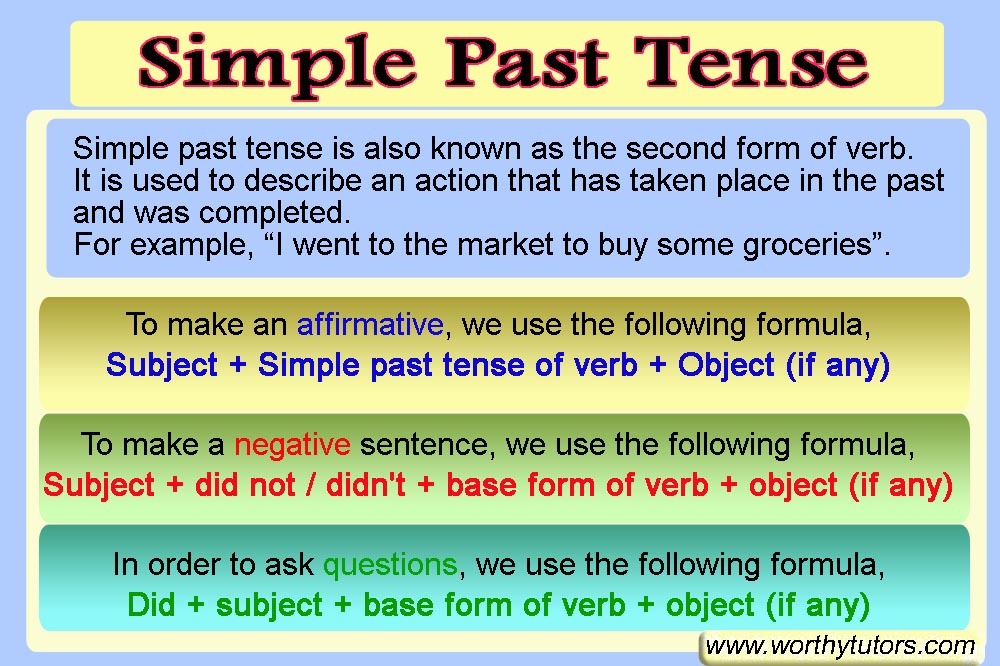
Simple Past Tense | English Grammar
Simple Past Tense
Introduction of Simple Past Tense
Simple past tense is also known as the second form of verb. It is used to describe an action that has taken place in the past and was completed.
For example,
· Elizabeth wrote a letter to her friend Liza, asking about her health.
· I went to the market to buy some groceries.
· Joseph and Amelia called for help when the fire broke out but nobody came.
The actions in the examples above are restricted to a specific time in the past and do not show any continuation or repetition. It happened once and was finished.
Apart from actions, simple past tense also describes how someone felt or the state the person was in in the past.
Examples,
· Mariah felt embarrassed as she slipped on the slope.
· Thomas was scared of walking through the woods alone.
Before getting into changing base forms of verb into simple past tense, we must get acquainted with the two groups of verbs, regular verbs and irregular verbs. The past tense (3rd form) of regular verbs is comparatively easier to form than that of irregular verbs. How do we know if a verb falls in the category of regular or irregular? There is no specific formula to know that. They need to be memorized.
Past tense of regular verbs:
For the regular verbs, we add -ed to the root form of verb. If the verb already ends in an -e, we only add -d to the base form of the verb. For example,
· Walk becomes walked
· Open becomes opened
· Compare becomes compared
· Love becomes loved
· Follow becomes followed
Past tense of irregular verbs:
We do not add -d or -ed to the base form of an irregular verb. For example,
· Fall becomes fell
· Break becomes broke
· See becomes saw
· Forget becomes forgot
· Come becomes forgot
Most of the time, the past tense of an irregular verb is the same as the base form of the verb. For example, the past tense of cast is cast, hit is hit, put is put, beat is beat and so on.
“To be” verb
The verb “to be” describes the condition of people, things, places and ideas. There are different forms of this specific verb, each of which is used according to the tense and the person. These include am, is are, was, were, been and being.
“Am, is and are” are the present form of the verb “to be”, while “was and were” are the past form of this verb.
Sentence structure for making simple past tense
To make an affirmative sentence in simple past tense, we use the following formula,
Subject + Simple past tense of verb + Object (if any)
Examples,
· Noah walked through the corridor and ran away.
· They loved to pet cats, but not dogs.
How to make negative sentences in simple past tense?
To make a negative sentence in simple past tense, we use the following formula,
Subject + did not / didn’t + base form of verb + object (if any)
For example,
· Alexander did not finish the food on his plate.
· I did not go to the art exhibition held in Paris last week.
We do not use did with to be verbs (was/were). Instead, we add the negating word “not “ right after this verb in a sentence.
For example,
· I was not in my right state of mind, because I had too much to deal with last week.
· They were not invited to the wedding for some personal reasons.
How to ask questions in simple past tense?
In order to ask questions in simple past tense, we use the following formula,
Did + subject + base form of verb + object (if any)
Examples,
· Did James come late from work last night?
· Did Daniel and David win the student council elections?
Again, the formula above does not apply to the verb “ be “. We follow the following pattern instead, in order to make a simple past tense sentence using the past form of “be” verb i.e. was and were,
Was/were + subject + Simple past tense of verb + object if any
Examples,
· Were Leana and Michael intimidated because they did not know what was in that box?
· Was Samantha offended by the decision they took?
Note: The mistake that has been repeatedly seen when making sentences with the verb did, is the use of past tense with it. We do not use the past tense of verb with did, instead we use the base form of verb with it.
Examples,
· Paul did not joined us for the meeting. (Incorrect)
· Paul did not join us for the meeting. (Correct)
You Might Be Interested In
- Past Continuous Tense
- Past Prefect Tense
- Past Prefect Continuous Tense
- Simple Present Tense
- Present Continuous Tense
- Present Perfect Tense
- Present Prefect Continuous Tense
- Simple Future Tense
- Future Continuous Tense
- Future Prefect Tense
- Future Continuous Prefect Tense
English Grammar
Tenses
Punctuation Marks
Parts of speech
Writing skills
Public Submissions
Testing/Exam
Grammar Rules
English Vocabulary